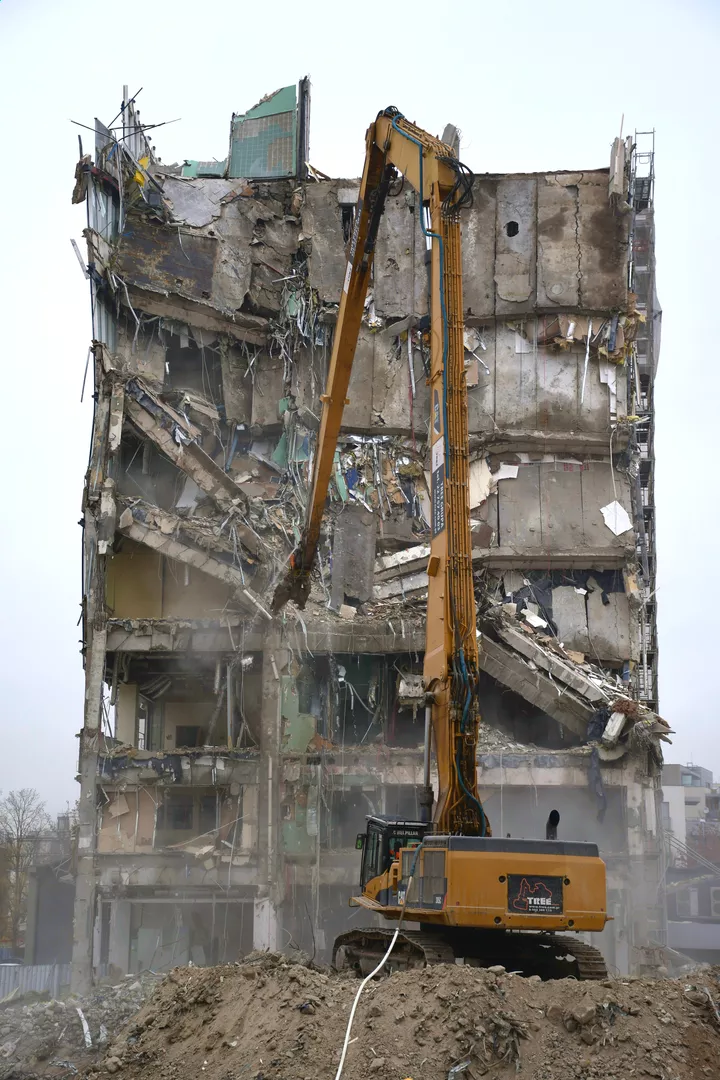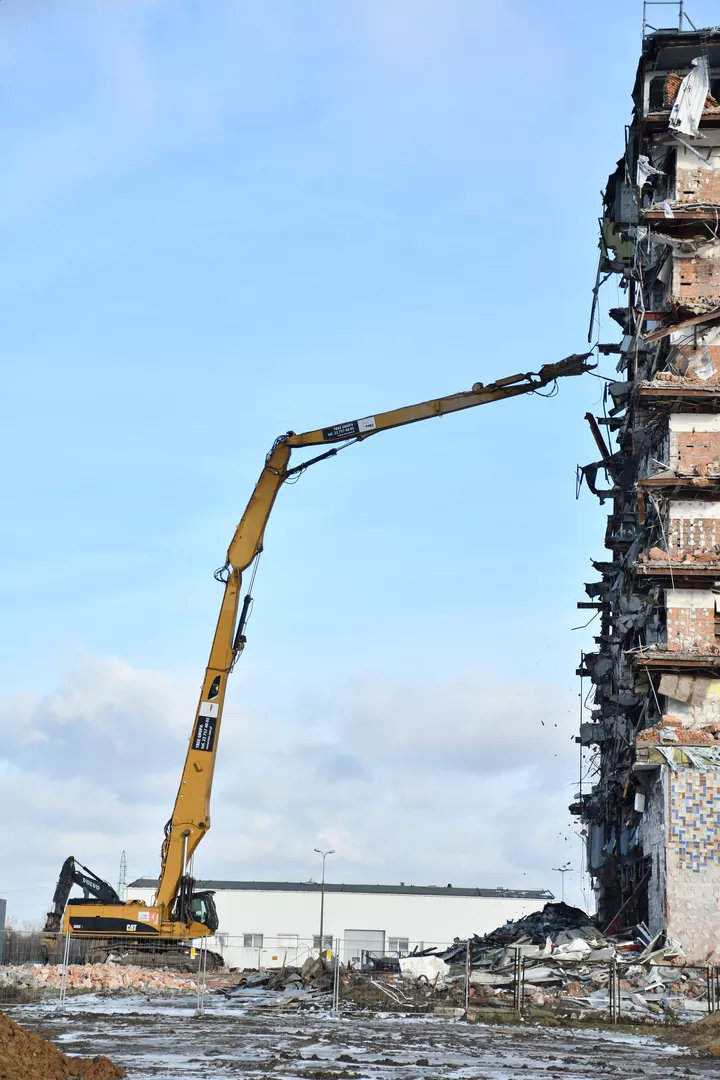
Hydraulic Hammer Operation in Demolition Work - Operator's Manual 2025
Detailed guide for safe and efficient hydraulic hammer operation in demolition work. Current 2025 procedures, equipment selection, maintenance, and techniques for noise and vibration minimization.
Hydraulic Hammer Operation in Demolition Work
Introduction
Hydraulic hammers constitute the primary tool in demolition work, accounting for approximately 70% of all demolition operations in Poland according to 2025 data. In the Warsaw region, over 800 hydraulic hammers of various classes are used annually, making knowledge of their operation a key competency for construction equipment operators.
Hydraulic Hammer Classification
Classification by Impact Energy
Light Class (500-1500 J):
- Weight: 200-500 kg
- Application: finishing work, partition wall demolition
- Base machines: 3-8 ton excavators
- Examples: Atlas Copco HB 1000, Rammer E 54
Medium Class (1500-4000 J):
- Weight: 500-1200 kg
- Application: reinforced concrete demolition, foundations
- Base machines: 8-20 ton excavators
- Examples: Soosan SB 40, NPK E-213A
Heavy Class (4000-8000 J):
- Weight: 1200-2500 kg
- Application: massive structure demolition, rocks
- Base machines: 20-40 ton excavators
- Examples: Atlas Copco HB 4100, Furukawa F 35
Super Heavy Class (>8000 J):
- Weight: >2500 kg
- Application: mining, infrastructure demolition
- Base machines: >40 ton excavators
- Examples: Rammer G 90, Soosan SB 151
Hammer Types by Construction
Single-direction Piston Hammers:
- Operating principle: single piston striking the tool
- Advantages: simple construction, low price
- Disadvantages: greater vibrations, higher noise
- Application: standard work
Damping System Hammers:
- Operating principle: additional vibration damping system
- Advantages: reduced vibrations transferred to machine
- Disadvantages: higher price, more complex construction
- Application: acoustically protected zone work
Oil Recirculation System Hammers:
- Operating principle: hydraulic oil circulates in closed circuit
- Advantages: higher efficiency, lower energy consumption
- Disadvantages: require special oil, more expensive operation
- Application: long-term demolition work
Hammer Selection for Task
Hammer Selection Criteria
1. Material type for demolition:
- Concrete C12/15-C25/30: 1500-3000 J hammers
- Concrete C30/37-C40/50: 3000-6000 J hammers
- High-strength concrete >C50/60: >6000 J hammers
- Sedimentary rock: 2000-4000 J hammers
- Igneous rock: >5000 J hammers
2. Material thickness:
- Up to 20 cm: 500-1500 J hammers
- 20-50 cm: 1500-4000 J hammers
- 50-100 cm: 4000-8000 J hammers
- Above 100 cm: >8000 J hammers
3. Environmental limitations:
- Residential zone: noise-reduced hammers
- Protected areas: vibration-damped hammers
- Night work: limitation to 65 dB(A)
- Building proximity: vibration control <3 mm/s
Required Impact Energy Calculation Formula
E = k × σ × V
Where:
- E = impact energy [J]
- k = material coefficient (concrete: 0.15; rock: 0.25)
- σ = compressive strength [MPa]
- V = removed material volume per hour [m³/h]
Operation Procedures
Pre-work Inspection
1. Hammer visual inspection:
- Housing condition and connection tightness
- Tool control (cracks, wear)
- Hydraulic hose checking
- Lubrication point verification
2. Hydraulic parameter control:
- Working pressure: according to manufacturer specification
- Oil flow: verification according to table
- Oil temperature: <80°C before start
- Oil cleanliness: filter control
3. Functional test:
- Idle startup tests
- Strike frequency control
- Automatic lubrication system test
- Error signaling check
Hydraulic Hammer Work Techniques
1. Hammer positioning:
- Strike angle: 90° to surface (optimal)
- 60-75° angle: acceptable for vertical walls
- Avoid angles <45° (hammer damage)
- Stable excavator arm support
2. Striking sequence:
- Point technique: concentration on one point
- Progressive technique: systematic movement
- Undercutting technique: cutting from base
- Segmental technique: division into parts
3. Optimal work parameters:
- Strike frequency: 300-1500 strikes/min
- Pressure force: 10-30% of hammer weight
- Continuous work time: max 2 hours
- Technical breaks: min 15 minutes every 2h
Lubrication and Maintenance
1. Automatic lubrication system:
- Grease type: multi-purpose lithium NLGI grade 2
- Lubrication interval: every 2-4 working hours
- Level control: daily before work
- Complete replacement: every 500 engine hours
2. Tool maintenance:
- Sharpening: every 50-100 working hours
- Crack control: daily
- Replacement: at >30% length wear
- Hardening: after 3-5 sharpenings
3. Periodic service:
- Every 50 engine hours: oil filter replacement
- Every 250 engine hours: seal control
- Every 500 engine hours: hydraulic oil replacement
- Every 1000 engine hours: main inspection
Work Safety
Personal Protective Equipment
Mandatory operator equipment:
- Protective helmet with chin strap
- Class F protective glasses (impact resistance)
- Protective headphones min 30 dB attenuation
- Class 3 reflective clothing
- S3 puncture-resistant footwear
- Anti-vibration gloves
Noise and Vibration Control
Permissible noise levels (2025):
- Industrial zone: 85 dB(A) during day
- Residential zone: 65 dB(A) during day, 55 dB(A) at night
- Protected areas: 50 dB(A) throughout 24 hours
- Reduction measures: acoustic screens, quiet hammers
Vibration control:
- Measurement at 10m distance from hammer
- Permissible: 5 mm/s for residential buildings
- Reduction methods: damping pads, work breaks
- Continuous monitoring: digital accelerometers
Safety Zones
Minimum distances (2025):
- Danger zone: 15m radius around hammer
- Protective zone: 30m for hammers >3000J
- Noise zone: 50m for daytime work
- Vibration zone: 25m from residential buildings
Operational Problem Solving
Most Common Failures and Solutions
1. Striking power drop:
- Cause: contaminated hydraulic oil
- Solution: oil and filter replacement
- Prevention: regular cleanliness control
2. Hammer overheating:
- Cause: too long continuous work
- Solution: technical breaks every 2h
- Prevention: temperature monitoring
3. Excessive vibrations:
- Cause: worn bearings, clearances
- Solution: component replacement
- Prevention: regular lubrication
4. Uneven operation:
- Cause: air in hydraulic system
- Solution: system bleeding
- Prevention: tightness control
Modern Diagnostics
2025 monitoring systems:
- IoT sensors: temperature, vibrations, pressure
- Predictive analysis: failure prediction
- Mobile applications: remote diagnostics
- Artificial intelligence: parameter optimization
Efficiency and Productivity
Performance Indicators
Basic indicators:
- Volumetric efficiency: 5-25 m³/h depending on material
- Fuel consumption: 8-15 l/h for excavators with hammer
- Trouble-free operation time: >95% for well-maintained hammers
- Operating cost: 80-150 PLN/engine hour
Efficiency optimization:
- Hammer-to-task matching: +30% efficiency
- Regular maintenance: +20% reliability
- Operator training: +25% efficiency
- Parameter monitoring: +15% savings
Operating Cost Analysis
Annual cost structure:
- Hammer depreciation: 40%
- Fuel and oils: 25%
- Service and repairs: 20%
- Tool replacement: 10%
- Insurance: 5%
2025 Technological Innovations
New Generation Hammers
Automatic systems:
- Auto-stop when no material contact
- Automatic striking power regulation
- GPS navigation system for precision
- BIM system integration
Eco-friendly technologies:
- 50% noise reduction (silent hammers)
- 30% energy savings
- Biodegradable lubrication materials
- Component recycling after use
Artificial Intelligence in Control
AI functions:
- Material type recognition
- Automatic parameter optimization
- Failure prediction
- Work condition adaptation
Legal Aspects and Certification
Legal Requirements (2025)
Hammer certificates:
- CE conformity declaration
- UDT type examination certificate
- Protected zone work permit
- Acoustic certificates for night work
Operator obligations:
- Current UDT qualifications
- Hydraulic hammer operation training
- Medical examinations every 3 years
- Civil liability insurance for activities
Operating Documentation
Required documents:
- Hammer work diary
- Periodic control protocols
- Maintenance and repair cards
- Noise and vibration measurements
Technology Development Trends
Development Directions to 2030
1. Electrification:
- Battery-powered hammers
- Hybrid drive systems
- Wireless charging
- Zero local emissions
2. Automation:
- Robots with autonomous hammers
- 5G remote control
- Artificial intelligence in planning
- Drone integration
3. Advanced materials:
- Carbon composites in construction
- Nano-coatings on tools
- Smart self-lubricating materials
- Biodegradable components
Training and Competency Development
Operator Training Program
Basic module (40 hours):
- Hydraulic hammer construction and operation
- Safe operation principles
- Maintenance basics
- OSH regulations
Advanced module (80 hours):
- Failure diagnostics
- Work parameter optimization
- Specialist techniques
- New technologies
Certification:
- Theoretical exam (100-question test)
- Practical exam (4 hours)
- Certificate validity: 5 years
- Renewal requirement: 16h training
Summary
Professional hydraulic hammer operation requires comprehensive technical knowledge, systematic safety approach, and continuous skill improvement. Modern 2025 technologies offer significantly greater work optimization possibilities but also require higher operator qualifications. Success key is combining traditional skills with modern support systems and strict adherence to safety and environmental protection procedures.
Bibliography
## Legal acts and standards:
- Ministry of Development Regulation on hydraulic hammer requirements, Official Journal 2024 item 1234
- PN-EN ISO 6165:2025 Earth-moving machinery - Basic types - Terminology
- PN-EN 474-1:2025 Earth-moving machinery - Safety - Part 1: General requirements
## Professional literature:
- Markowski, J. (2025). "Hydraulic hammers in construction - theory and practice", WNT Publishing, Warsaw
- Anderson, R., Schmidt, K. (2024). "Modern Hydraulic Hammer Technology", Construction Equipment Magazine, vol. 67
- Kowalski, M., Nowak, A. (2025). "Hydraulic hammer diagnostics and maintenance", Mining Mechanization and Automation, no. 3
## Industry standards:
- European Committee for Standardization (2025). "EN 13309:2025 Construction machinery - Hydraulic hammers"
- International Association of Demolition Contractors (2024). "Best Practices for Hydraulic Hammer Operation"
- Hydraulic Hammer Manufacturers Association (2025). "Technical Guidelines for Safe Operation"
## Technical reports:
- Atlas Copco Construction Tools (2025). "Hydraulic Hammer Efficiency Report 2024-2025"
- European Construction Equipment Association (2024). "Market Analysis: Hydraulic Hammers in Europe"
- Polish Construction Employers Association (2025). "Analysis of hydraulic hammer use in Poland"
Tags
Share this guide
About the author
dr inż. Marek Nowicki
Senior Hydraulic Hammer Operation Instructor at Tree Group
Category
For Operators
Reading time
14 minutes
Publication date
May 29, 2025
Similar guides

Excavator Operation Manual for Residential Building Demolitions - Operator's Guide 2025
Practical guide for safe excavator operation during residential building demolitions. Contains latest 2025 procedures, l...

Safe Reinforced Concrete Structure Demolition Techniques - Operator's Guide 2025
Comprehensive guide to safe reinforced concrete structure demolition techniques. Current 2025 procedures, structural ass...